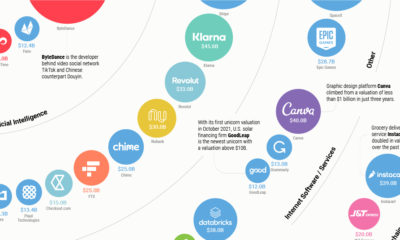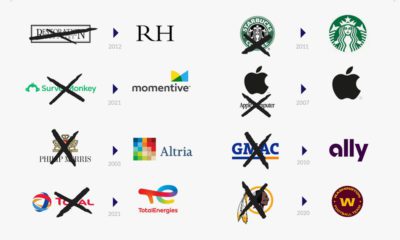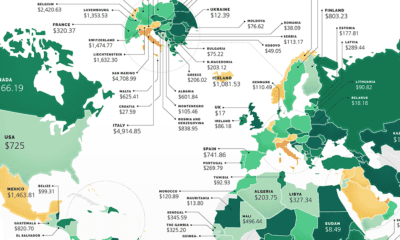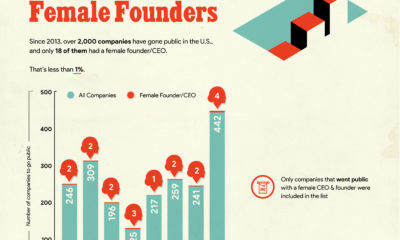The Narwhal Club: Home to Canada’s $1 Billion Dollar Tech Startups
Created by Garibaldi Capital Advisors and Visual Capitalist
October 2015 Update:
The Narwhal Club is going strong with plenty of recent news concerning prominent Canadian startups. Working with Brent Holliday from Garibaldi Capital Advisors, we got the latest scoop on the sector and have updated the narwhal list accordingly.
The most recent notable event occurred in the summer of 2015, when Markus Frind sold his 100% owned Plentyoffish.com to Match Group for US$575 million. As a result, we have removed POF from the Narwhal list, and instead have inducted Markus to a new category called the Nar-Wall of Fame. Plentyoffish.com allowed Markus to amass a personal fortune from profits and sale of his business that makes his personal valuation Narwhal-esque.
Next, with its recent raise of $50 million from China’s Tencent, a new narwhal was born. Kik Interactive is now valued at over the coveted $1 billion mark, and claims to have over 240 million users in 230 countries worldwide. Kik is a chatting application that competes directly with the likes of Snapchat among younger demographics.
Lastly, three new “emerging narwhals” have been added to the list. Enerkem uses proprietary technology to convert non-recyclable waste into clean energy products, and most recently raised C$152.6 million from financings. Intelex, a software company providing web-based management systems, is also now on the emerging list after securing C$160 in strategic growth funding. The third new entry is Lightspeed POS, a company that just raised US$61 million in September for its point-of-sales systems.
The Narwhal Club
Original writeup published December 2014
In 2013, Aileen Lee of Kleiner Perkins Caufield & Byers came up with the concept of the “Unicorn Club”, for tech startups reaching valuations of $1 billion or more. For venture capitalists, this number is much like unicorns themselves – very magical. It resembles big potential exits that can make up for all the startup investments that don’t pan out.
Brent Holliday at Garibaldi Capital Advisors, a Vancouver-based capital advisory with a focus on technology, thought there needed to be a Canadian equivalent. He created the concept of the “Narwhal Club”, based on the uni-horned Canadian animal that actually exists and roams the frigid seas of the North. This club represents companies with $1B CAD valuations that started in 1999 or later.
While there are more than 40 unicorns in existence in the US, there are only four members of the Narwhal Club in Canada: Avigilon, Hootsuite, Slack, and Shopify. However, there are many companies getting close to breaking the ice – these are companies we consider to be emerging narwhals, with valuations in the hundreds of millions with great growth rates.
Some of these include Desire2Learn, Vision Critical, Redknee, Real Matters, iQmetrix, PointClickCare, BuildDirect, DWave, and Wattpad.
We will be updating this list quarterly based on the latest public financing round available. If you know of a company that could fit either category, contact us here. Alternatively, connect with us below.
on But fast forward to the end of last week, and SVB was shuttered by regulators after a panic-induced bank run. So, how exactly did this happen? We dig in below.
Road to a Bank Run
SVB and its customers generally thrived during the low interest rate era, but as rates rose, SVB found itself more exposed to risk than a typical bank. Even so, at the end of 2022, the bank’s balance sheet showed no cause for alarm.
As well, the bank was viewed positively in a number of places. Most Wall Street analyst ratings were overwhelmingly positive on the bank’s stock, and Forbes had just added the bank to its Financial All-Stars list. Outward signs of trouble emerged on Wednesday, March 8th, when SVB surprised investors with news that the bank needed to raise more than $2 billion to shore up its balance sheet. The reaction from prominent venture capitalists was not positive, with Coatue Management, Union Square Ventures, and Peter Thiel’s Founders Fund moving to limit exposure to the 40-year-old bank. The influence of these firms is believed to have added fuel to the fire, and a bank run ensued. Also influencing decision making was the fact that SVB had the highest percentage of uninsured domestic deposits of all big banks. These totaled nearly $152 billion, or about 97% of all deposits. By the end of the day, customers had tried to withdraw $42 billion in deposits.
What Triggered the SVB Collapse?
While the collapse of SVB took place over the course of 44 hours, its roots trace back to the early pandemic years. In 2021, U.S. venture capital-backed companies raised a record $330 billion—double the amount seen in 2020. At the time, interest rates were at rock-bottom levels to help buoy the economy. Matt Levine sums up the situation well: “When interest rates are low everywhere, a dollar in 20 years is about as good as a dollar today, so a startup whose business model is “we will lose money for a decade building artificial intelligence, and then rake in lots of money in the far future” sounds pretty good. When interest rates are higher, a dollar today is better than a dollar tomorrow, so investors want cash flows. When interest rates were low for a long time, and suddenly become high, all the money that was rushing to your customers is suddenly cut off.” Source: Pitchbook Why is this important? During this time, SVB received billions of dollars from these venture-backed clients. In one year alone, their deposits increased 100%. They took these funds and invested them in longer-term bonds. As a result, this created a dangerous trap as the company expected rates would remain low. During this time, SVB invested in bonds at the top of the market. As interest rates rose higher and bond prices declined, SVB started taking major losses on their long-term bond holdings.
Losses Fueling a Liquidity Crunch
When SVB reported its fourth quarter results in early 2023, Moody’s Investor Service, a credit rating agency took notice. In early March, it said that SVB was at high risk for a downgrade due to its significant unrealized losses. In response, SVB looked to sell $2 billion of its investments at a loss to help boost liquidity for its struggling balance sheet. Soon, more hedge funds and venture investors realized SVB could be on thin ice. Depositors withdrew funds in droves, spurring a liquidity squeeze and prompting California regulators and the FDIC to step in and shut down the bank.
What Happens Now?
While much of SVB’s activity was focused on the tech sector, the bank’s shocking collapse has rattled a financial sector that is already on edge.
The four biggest U.S. banks lost a combined $52 billion the day before the SVB collapse. On Friday, other banking stocks saw double-digit drops, including Signature Bank (-23%), First Republic (-15%), and Silvergate Capital (-11%).
Source: Morningstar Direct. *Represents March 9 data, trading halted on March 10.
When the dust settles, it’s hard to predict the ripple effects that will emerge from this dramatic event. For investors, the Secretary of the Treasury Janet Yellen announced confidence in the banking system remaining resilient, noting that regulators have the proper tools in response to the issue.
But others have seen trouble brewing as far back as 2020 (or earlier) when commercial banking assets were skyrocketing and banks were buying bonds when rates were low.














